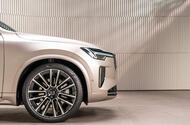Swedish brand this week reneged on its pledge to go electric-only by 2030 as it introduced a revamped XC90
Volvo‘s line-up could swell to an “abnormal” number in the coming years as a result of the firm abandoning its target of going electric-only by 2030, according to the firm’s deputy CEO – who insists the firm is “well-placed” to handle that.
The Swedish brand pledged in 2021 that it would sell only electric cars from the start of the next decade. But the slow uptake of EVs in some global markets and the recent decline in EV sales growth has prompted Volvo to renege on that.
Volvo is now aiming for between 90% and 100% of its global sales by 2030 to be electrified cars (PHEV or electric), with the remainder mild hybrids.
It expects PHEVs and EVs to account for between 50% and 60% of its line-up by 2025, up from 48% at present.
The decision to scrap the target was made at Volvo’s ’90/90 Day’, at which it launched a heavily updated version of the XC90 that will be sold alongside the new EX90 EV.
While Volvo remains committed to its launch programme for new EVs, which includes the ES90 saloon next year, Björn Annwall said the lifespan of other existing petrol models could be extended.
“If we want to be consistent with the strategy that we believe we’re going to be fully electric but we accept that it takes longer, keeping the existing cars alive a little bit longer, something like that could make sense,” said Annwall.
“Having the strength in a size class of being able to offer fully electric, plug-in hybrid and mild hybrid gives us flexibility.
“One of the advantages of Volvo is that we have quite a narrow model range of six, seven, eight cars, whereas our German competitors have like 30 or 40 cars.
“In this transition period from an ICE world to a BEV world, we can temporarily have a broader product portfolio: we can have seven BEVs and we can have seven cars with mild and plug-in hybrids. So we have 14 cars for a while, but that’s fine, because we can still handle it.
“Some of our competitors can’t have 35 cars here and 35 there; they can’t have 70 cars. We can handle this transition by having an abnormally large model portfolio for a while.”
Annwall insisted that Volvo could still be a market leader in electrification, saying that “leadership is about having a clear vision, but it’s also about adjusting to reality”.
He added: “Leadership is not only saying what you’re going to do seven years from now; leadership is delivering here and now.
“If you compare Volvo to any of our traditional competitors, we’re selling more BEV. We sell 48% electrified cars right now, with 26% full electric. That’s far ahead of our competitors. So we are leading, and we are going to continue to lead. Then the question is: with which margin should you lead?”
Volvo boss: we are pragmatic, not dogmatic
Volvo CEO Jim Rowan said the decision to renege on the 2030 pledge didn’t affect Volvo’s commitment to electrification.
The firm is currently developing a new platform and a new generation of motors, along with an advanced new software architecture that will underpin its future EVs.
It previously sold its ICE development division to Aurobay, which will continue to develop the MHEV and PHEV powertrains that Volvo will use.
Aurobay was formed as a joint venture between Volvo and its parent firm Geely, although Volvo has now divested its stake.
Asked by Autocar how far ahead Volvo would need to decide on a final phase-out date for non-EV models, Rowan said: “We don’t need to make a final decision. It depends if legislation changes, but we’re never in control of that, of course, right?
“I’m neither an optimist nor a pessimist, I’m a pragmatist. When an industry is going through so much change so profoundly, then pragmatism is going to win the day.”
He added: “My job as a CEO is to position the company [such] that if the road has to veer to the left, we can veer to the left, if it has to be veer to the right, we can veer to the right.
“With the MHEVs and PHEVs and the BEVs we’re developing, I’m going to allow the company to make those choices much later in the day than we maybe thought we’d need to. If that means we need to continue to invest in MHEVs and PHEVs for longer than we thought, that that’s okay.”
Rowan added: “We never saw the pandemic coming, we never saw the semiconductor shortage coming. We can be dogmatic about this and say that we said we’d be a full electric car company by 2030 and just ignore everything that’s going on in the marketplace right now. That’s not pragmatism, that’s dogmatism.
“I’m saying that it might take a little bit longer. We have the technology, we have great cars, we have a customer base that really likes MHEVs and PHEVs, so let’s give the market what it needs.”







